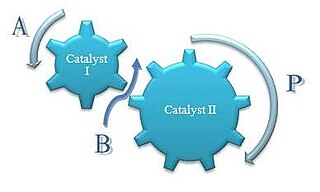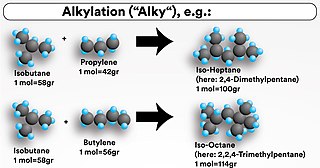The molecular formula C4H8 (molar mass: 56.11 g/mol) may refer to:
- Butenes (butylenes)
- 1-Butene, or 1-butylene
- 2-Butene
- Isobutylene
- Cyclobutane
- Methylcyclopropane
The molecular formula C4H8 (molar mass: 56.11 g/mol) may refer to:

In organic chemistry, an alkene, or olefin, is a hydrocarbon containing a carbon–carbon double bond. The double bond may be internal or in the terminal position. Terminal alkenes are also known as α-olefins.

Octane is a hydrocarbon and an alkane with the chemical formula C8H18, and the condensed structural formula CH3(CH2)6CH3. Octane has many structural isomers that differ by the location of branching in the carbon chain. One of these isomers, 2,2,4-trimethylpentane (commonly called iso-octane), is used as one of the standard values in the octane rating scale.
Butene, also known as butylene, is an alkene with the formula C4H8. The word butene may refer to any of the individual compounds. They are colourless gases that are present in crude oil as a minor constituent in quantities that are too small for viable extraction. Butene is therefore obtained by catalytic cracking of long-chain hydrocarbons left during refining of crude oil. Cracking produces a mixture of products, and the butene is extracted from this by fractional distillation.

Isobutylene is a hydrocarbon with the chemical formula (CH3)2C=CH2. It is a four-carbon branched alkene (olefin), one of the four isomers of butylene. It is a colorless flammable gas, and is of considerable industrial value.

In organic chemistry, terminal alkenes are a family of organic compounds which are alkenes with a chemical formula CxH2x, distinguished by having a double bond at the primary, alpha (α), or 1- position. This location of a double bond enhances the reactivity of the compound and makes it useful for a number of applications.
The molecular formula C4H8O2 may refer to:

1-Butene (IUPAC name: But-1-ene, also known as 1-butylene) is the organic compound with the formula CH3CH2CH=CH2. It is a colorless gas. But-1-ene is an alkene easily condensed to give a colorless liquid. It is classified as a linear alpha-olefin (terminal alkene). It is one of the isomers of butene (butylene). It is a precursor to diverse products.

1-Nonanol is a straight chain fatty alcohol with nine carbon atoms and the molecular formula CH3(CH2)8OH. It is a colorless oily liquid with a citrus odor similar to citronella oil.

Butane-1-thiol, also known as butyl mercaptan, is a volatile, clear to yellowish liquid with a fetid odor, commonly described as "skunk" odor. In fact, 1-butanethiol is structurally similar to several major constituents of a skunk's defensive spray but is not actually present in the spray. The scent of 1-butanethiol is so strong that the human nose can easily detect it in the air at concentrations as low as 10 parts per billion. The threshold level for 1-butanethiol is reported as 1.4 ppb

Pentanal is the organic compound with molecular formula C4H9CHO. Classified as an alkyl aldehyde, it is a colorless volatile liquid. Its odor is described as fermented, bready, fruity, nutty, berry.

C5H10 is the molecular formula of 13 hydrocarbon isomers (represented by their CAS numbers on the chart). They can be divided into cycloalkanes and alkenes.
The molecular formula C5H8O3 may refer to:
The molecular formula C6H12 may refer to following structural isomers:
2-Bromobutane is an isomer of 1-bromobutane. Both compounds share the molecular formula C4H9Br. 2-Bromobutane is also known as sec-butyl bromide or methylethylbromomethane. Because it contains bromine, a halogen, it is part of a larger class of compounds known as alkyl halides. It is a colorless liquid with a pleasant odor. Because the carbon atom connected to the bromine is connected to two other carbons the molecule is referred to as a secondary alkyl halide. 2-Bromobutane is chiral and thus can be obtained as either of two enantiomers designated as (R)-(−)-2-bromobutane and (S)-(+)-2-bromobutane.

2-Methyl-2-butene, 2m2b, 2-methylbut-2-ene, beta-isoamylene, or Trimmethylethylene is an alkene hydrocarbon with the molecular formula C5H10.

Concurrent tandem catalysis (CTC) is a technique in chemistry where multiple catalysts produce a product otherwise not accessible by a single catalyst. It is usually practiced as homogeneous catalysis. Scheme 1 illustrates this process. Molecule A enters this catalytic system to produce the comonomer, B, which along with A enters the next catalytic process to produce the final product, P. This one-pot approach can decrease product loss from isolation or purification of intermediates. Reactions with relatively unstable products can be generated as intermediates because they are only transient species and are immediately used in a consecutive reaction.
The molecular formula C5H10S (molar mass: 102.20 g/mol, exact mass: 102.0503 u) may refer to:

An alkylation unit (alky) is one of the conversion processes used in petroleum refineries. It is used to convert isobutane and low-molecular-weight alkenes (primarily a mixture of propene and butene) into alkylate, a high octane gasoline component. The process occurs in the presence of an acid such as sulfuric acid (H2SO4) or hydrofluoric acid (HF) as catalyst. Depending on the acid used, the unit is called a sulfuric acid alkylation unit (SAAU) or hydrofluoric acid alkylation unit (HFAU). In short, the alky produces a high-quality gasoline blending stock by combining two shorter hydrocarbon molecules into one longer chain gasoline-range molecule by mixing isobutane with a light olefin such as propylene or butylene from the refinery's fluid catalytic cracking unit (FCCU) in the presence of an acid catalyst.

Hafnium acetylacetonate, also known as Hf(acac)4, is a coordination compound with formula Hf(C5H7O2)4. This white solid is the main hafnium complex of acetylacetonate. The complex has a square antiprismatic geometry with eight nearly equivalent Hf-O bonds. The molecular symmetry is D2, i.e., the complex is chiral. It is prepared from hafnium tetrachloride and acetylacetone, and base. Zr(acac)4 is very similar in structure and properties.
Dimethylbutene is an alkene with a molecular formula C6H12. It has the following possible structural isomers: